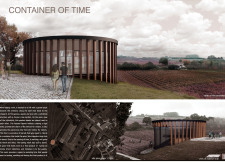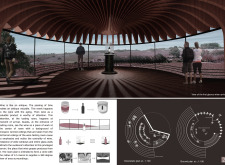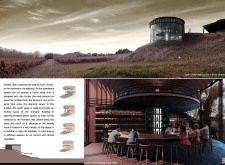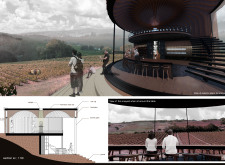5 key facts about this project
The building incorporates a palette of materials including wood, glass, iron, and concrete. Wood is predominant, providing an inviting atmosphere and warmth, while large glass panels facilitate natural light and stunning views of the vineyard. Iron elements support the structure, enhancing durability. Concrete forms the foundation, ensuring stability. The incorporation of dynamic glass technology allows for adjustments in transparency based on environmental conditions, optimizing energy efficiency.
Spatial organization is a vital aspect of the design. The central area welcomes visitors and features a large barrel-shaped table designed for wine sampling. Surrounding spaces encourage interaction, incorporating stairways leading to lower levels where guests can enjoy panoramic views. This functional layout fosters a sense of community at the tasting events by facilitating conversation and connection to the environment.
Innovative design approaches set this project apart from typical wine tasting rooms. The circular configuration promotes an inclusive atmosphere, allowing every visitor to engage with their surroundings fully. Moreover, the structure’s roof resembles a barrel's curvature, reinforcing the overarching theme of aging and time in relation to wine production. Such details make the project relevant in discussions about contemporary architecture in the hospitality sector.
For those interested in further exploring the architectural elements of the "Container of Time," including architectural plans, architectural sections, and architectural designs, a detailed presentation is available for review. This offers deeper insights into the design ideas and spatial concepts that define this unique project.


























